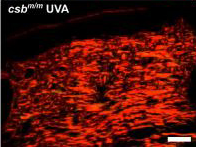
Cancer drug cures orphan disease skin damage
An FDA-approved cancer drug stops light sensitivity of the skin in Cockayne syndrome (CS), an ultra-rare hereditary disease characterised by premature aging, German researchers report.
Patients with the incurable cockayne syndrome suffer from dwarfism, neurological impairment, premature aging and a shortened life span. In 80% of cases, the disease is caused by a mutation in the CSB gene that is involved in DNA repair when located in the nucleus. However, skin symptoms such as the striking sensitivity to UV rays and a dramatic loss of subcutaneous fat could not be attributed to DNA repair deficiency.
A team headed by Jean Krutmann from University of Dusseldorf, Germany, now have shown that administration of the the pan-histone deacetylase inhibitor vorinostat (SAHA, suberoylanilide hydroxamine), which is FDA-approved to treat cutaneous T cell lymphoma, reversed the skin symptoms in naked CSB-deficient mice.
Model mice treated with the drug, originally developed by French Invivogen SA, didn’t show the characteristic loss of subcutaneous fat and overproduction of collagen in the skin following UV radiation.
As Kruthmann et al. could demonstrate, a fraction of the CSB protein can be found at the centrosome, where it colocalizes with the alpha-tubulin acetyltransferase MEC-17 and the histone deacetylase HDAC6, which interact to catalyse the acetylation of alpha-tubulin. Acetyl-alpha-tubulin triggers an anti-stress cell debris recycling reaction called autophagy. When mutated, CSB is less active leading to minor activation of the process. Inhibition of HDAC6 by vorinostat, however, restored the capacity to activate autophagy, which prevented the mice from UV-induced skin damage and loss of subcutaneous fat. The authors now say clinical studies are warranted to see if vorinostat could be used to treat skin abnormalities and other symptoms in CS patients.
"More and more biological functions beyond DNA repair are being discovered for proteins, which were originally described as DNA repair enzymes, said Kruthmann. Examples are the CSB protein but also the XPA protein which causes a very severe subtype of Xeroderma pigmentosum. This paradigm shift might allow us to identify new strategies for the treatment of these incurable diseases".


 Bayer AG
Bayer AG
 Picture from Ferdinand Stöhr on Unsplash
Picture from Ferdinand Stöhr on Unsplash